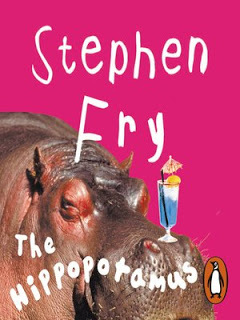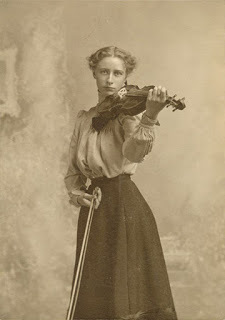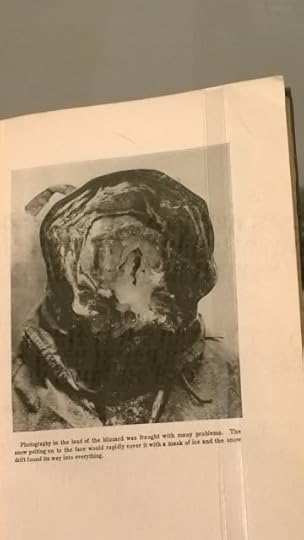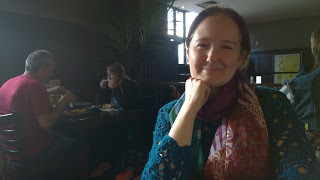E.L. Parfitt's Blog, page 2
April 30, 2020
The hippopotamus by Stephen Fry
 Surprised I managed to finish it, what with juggling work and writing and some time for relaxation and mental health, but this month I read the above novel. And I am struck by the characterisation of The hippopotamus, and thus delved deeper into Stephen Fry’s writing psyche. But not that deepily; at least, not to the depths of a hippo with a cocktail on its nose.
Surprised I managed to finish it, what with juggling work and writing and some time for relaxation and mental health, but this month I read the above novel. And I am struck by the characterisation of The hippopotamus, and thus delved deeper into Stephen Fry’s writing psyche. But not that deepily; at least, not to the depths of a hippo with a cocktail on its nose.The main character of the book is poet and newspaper columnist (and hippo), Ted Wallace. It’s clear from the initial scene that he’s got an inflated sense of self importance as he gets fired and goes to stay with relatives.
I had just been sacked from my paper, some frantic piffle about shouting insults from the stalls at first night.I love these creative descriptions of his editor, that, note, also describe his contempt:
my wet turd of an editor had shrilled
the kind of anile little runt who, in foyers and theatre bars the West End over, can be heard bleating into their gin and tonicsI pause to laugh. Possibly on my own?
Fry's prose is full of such well-chosen details I’m envious. This is the advantage of first-person narrative. However, the book also switches into third person at stages with clever references to random things like sex with horses and yogic meditation that keep me thinking long after I read the last page. Notably, in third person Fry's characterisation shifts to inner dialogue:
The absolute rightness and holiness and perfection and beauty of life charged through him. In this position he could stay for ever, he and the whole kingdom of life
He thought of a circle and within that circle, another circle […] The technique came from a book on yogic mediation he had bought last holidaysLayers of believable details flow on the page due to Fry’s use of sentence construction. After reading his book about poetry construction (The Ode Less Travelled) his writing style doesn't surprise me.
Writing is a lengthy process the reader is usually unaware of: first draft (inspiration), second draft (restructuring and details); third draft (editing errors, inconsistencies, wondering if you can write at all); forth draft (polishing), then often going back to the beginning and starting again.
For my current book (working title: Fran) I’m constructing the details at the moment: those of her life, her children’s and husband’s life and the people she comes into contact with. Then I will be looking into sentence construction in more depth.
I have a book to read on grammar and style that may provide further insights: Grammar as Style by Virginia Tufte. Anyone else read it?
Published on April 30, 2020 07:46
April 2, 2020
Writing in turbulent times (unedited thoughts of a writer)
 Post-Brexit, coronavirus, whatever the current political or global crisis writers keep writing. Don't they? Not always. During 9/11 it has been noted that creativity took a nosedive... okay, I'm going to be honest here... I couldn't find my original reference. Some years ago I read something related to something. Just kidding. I read an article related to trauma and it discussed that when 9/11 happened writer productivity/submissions to publishers fell. Apparently everyone was too shocked to write. As that would require some semblance of normalcy. Please tell me if you find this article back as I would love to reread it. Anyhow, now my thinking has changed. A lot has also happened in my life since 9/11, my student days, when I worked part-time as a cleaner to pay my way through university. Not to mention, the fallout from 9/11 such as increased airport security and the hoops we now must jump through. Sigh. On a more optimistic slant, I have discovered living in the UK during these Post-Brexit and coronavirus times that uncertainty isn’t stifling my writing. It’s fuelling it.
Post-Brexit, coronavirus, whatever the current political or global crisis writers keep writing. Don't they? Not always. During 9/11 it has been noted that creativity took a nosedive... okay, I'm going to be honest here... I couldn't find my original reference. Some years ago I read something related to something. Just kidding. I read an article related to trauma and it discussed that when 9/11 happened writer productivity/submissions to publishers fell. Apparently everyone was too shocked to write. As that would require some semblance of normalcy. Please tell me if you find this article back as I would love to reread it. Anyhow, now my thinking has changed. A lot has also happened in my life since 9/11, my student days, when I worked part-time as a cleaner to pay my way through university. Not to mention, the fallout from 9/11 such as increased airport security and the hoops we now must jump through. Sigh. On a more optimistic slant, I have discovered living in the UK during these Post-Brexit and coronavirus times that uncertainty isn’t stifling my writing. It’s fuelling it.This is because my current writing project (a novel: working title Fran) is based in the here and now. I had intended it to relate to the current political climate a year ago. What I did not expect was a virus to emerge from Wuhan, China. Awkward. I had plotted out the challenges my characters would face in their nice insulated normal world only to have it blow up in my face. So, here I had a choice. Since, throwing the whole thing out, after already making multiple changes and deleting 15,000 words for one character that just didn’t fit the direction I wanted to take my novel in I started to rewrite. Without revealing too much, here are two changes I needed to make:
Fran got a new part-time job… um, well, she’s unable to go to work now. So I had to move some fragments for this around.
People in Fran’s circle were going to offer to look after her children. Now self-isolation makes that impossible
Suddenly, smaller details of the world I had created also had to shift. Conversations with neighbours and work colleges, became queuing for one’s shopping with a two-metre distance rule.
I have to tell you; I am enjoying the process.
This is a chance for me, living through these changes to take a snapshot of what is going on for future generations. Possibly inspired by La Terre by Émile Zola while written in a modern style. I won’t go into excruciating detail about supporting characters, for instance. Well, not too many of them.
For example, isn't it strange that it's becoming normalised to end messages with 'stay safe'?
So the book I intended to write will, I think, I hope, end up being completely different, yet better, by the end of this strange process called writing. That gives me hope. Hope that life will return to “normal”, hope that the book will be published, and hope that I will write something that speaks about current times and the way unprivileged people in society are living through turbulent political times.
Published on April 02, 2020 06:52
September 10, 2018
Edinburgh pride

Unfortunately, over the past twenty years I have noticed a frustrating increase in littering and fly tipping all over Edinburgh. But perhaps I should reassess if that matters at all, if random passers-by in Edinburgh are the best kind to have by your side in an emergency.
Yesterday in Edinburgh, I saw a man step off a Lothian bus on the bridges. He could have been anyone’s dad or granddad, he could have been you. One moment he was standing, the next it looked like he lost his balance and fell with his head against the large rubber tyre of the bus. People nearby immediately surrounded and comforted him: one asked the driver not to start the bus, another bent down to see if the man was conscious, another pulled out their phone and called for an ambulance. Luckily a doctor was on the bus heading to the airport. He assessed the gentleman’s condition and asked his name, as others offered wet-wipes to clean the blood from a slight gash on the gentleman’s forehead, and some bottled water for him to drink.
The thing I took away from yesterday ̶ as a young man and women crouched on the pavement with the gentleman, telling him that he was ‘in good hands’ ̶ was how glad I am to be Scottish; that while people worry about the unity of the UK, there are other things that are more important in our day-to-day lives. To be from Edinburgh, or quite possibly British, or European, or to be human for that matter, as I don’t know where everyone came from yesterday, the thing that should matter the most is the way that we treat one another. Consider, the concern of the medical student who stopped to ask if she could help after the doctor had to leave to catch his flight. I was inspired by the number of people who showed concern for a stranger in need ̶ people with a beautiful diversity of facial features and fashion statements.
Och, the littering-thingy still bugs me. Edinburgh is so beautiful, we have the right people, now we need to be proud of our surroundings too. Aye?
If you do want to help our environment in term of practical conservation work, check out LCV Edinburgh.
Published on September 10, 2018 08:20
September 8, 2018
The non-violent violinist
A poem inspired by a conversation with Dorota and Stéphane, with a nod to Debra Basset’s research on digital grieving.

The violin, in itself, is not violent.
What if, says the artist to herself,
the instrument’s lines and angles are a shared mental framework of hidden influences and meanings.
The bow, for instance, thrums across one’s deadened consciousness,
strokes a beat across the heart and back again.
The violin is almost drawing blood in the way it shakes me awake.
A violinist can create a crisscross of cuts in the ice of a soul as easily as soothe and glide.
Its movements start soft, the space between the notes casting the magic of a first lover’s kiss.
Gaining momentum, squiggles on pulped leave dance pirouettes, marionette-like shadows across the lines.
I don’t know what it was like to live amongst candlelight and clicking piano keys,
when the only entertainment was string, wind or percussion.
The miracle of live experience still occurs due to the privilege of electric currency ̶ digital money.
What a crime to compare the virtual to the living!
Digital avatars beckon Beethoven, Shubert and Seuerling to foxtrot from their graves in binary revolution.
The metamorphosis has commenced, c'est-à-dire… (it’s so cultured, even now, to throw in some French)…
let’s close our eyes and breathe it in.
Escape one simulated world for another one.
The passion of the non-violent violinist traverses the pores of our skin, sinking into sinew and bone with pinpricks of pleasure.
The violinist does not produce a flat tinny sound from a digital device. This is real music. Live. Transcendent.
As the music reaches for its applause there is always the promise of another tune…
like the lullabies that welcomed us into this world.
A lullaby of slaps
from a violent violinist
watered down by kindness and love.
Published on September 08, 2018 04:24
September 5, 2017
Should academia require endurance or empathy?
After meeting a friend and discussing the highs and lows of PhD life and academia recently, I then went to see the Enduring Eye exhibition at the National Library of Scotland, Edinburgh. The exhibition is a stunning display of photographs of Sir Ernest Shackleton's 'Endurance Expedition' of 1914-1917.

Being in academia right now kind of feels like being trapped in an iced-in ship, that is, in a hostile environment not suited to human beings. By no means do I intend to underplay the harsh experiences faced by the crew of the Endurance. But neither should we underestimate the mental and physical levy that is currently the “norm” of academia.

Here is the optimistic part of my post, working conditions are what we decide to make them. As we move into post-Brexit times it has never been more important to create good working conditions… at the forefront of this emphasis should be our universities, which are supposed to be focused on education and research, In other words, on people and their (our) striving towards better things…

The PhD process, post-doctorate and academic life is fraught with many dangers. I, amongst others, have not been immune to this. I will not share friend's stories, but I will share a bit of mine, in that I suffered both mentally and physically in order to write journal articles, a thesis, do part-time work, look after undergraduates, write grant proposals, and get fellowships and funding. When the stress affected my health and I realised the harsh consequences of this, I made a conscious decision to be the change I wanted to see. I am not perfect, can anyone say that? I was inspired by people I observed in my department. The staff that took the extra time not just to give you feedback in a constructive way but also checked on how you were doing. The fellow academics that shared not just their stories of success—the performing social media persona I have come to loathe—also their stories of difficulty and perserverance.
The question we need to ask is what should our real perserverance be towards?

The above quote, and the one following, could be used to describe the life of a time-stressed academic working away at their desk...

Here comes the core of my article, what kind of place do we want to live and work in? If I suggest small changes like resisting the journal writing, the high performing wire of the 'career path', what are your first thoughts and feelings? Perhaps ones of horror… how on earth can I complete with Charlie, Amir and Samantha, without publishing one book and several hundred academic papers?
Honestly, you might not be able to. Academic skills can however be used out of the workplace, and surely that is better for mental and physical health than an academic burn out? I am probably not being controversial enough... It’s going to be hard for those that stick around in academia. Those that somehow survive year by year postdoctorate contracts are lucky. I have decided not to follow this route, because shock horror I am not an upper class individual and I need to cover my rent, food and heating. That academia is for the rich and the prividledged is nothing new. So here I (we?) are striking out on an alternative path.

Somehow I doubt we will end up frozen to the rocky tundra. The happy news is that Shackleton’s crew made it. Remarkably every one survived. My thoughts lately have been circling around that, survival alone is not enough, there is a certain quality of life I want and a lot of that does not revolve around money but less stress. The time to potter around in my garden without the stress of rewriting an academic article that might never be published all because I am told my work is not judged on its benefit to others but the number of journal articles that are accepted. Grrr!

As a sociologist it was natural that I interpret the Enduring Eye exhibition through my own reflexivity. I have not said anything new, just added one more voice to a growing number of articles recently. That academia pushes out the underprividledged, that working conditions are unsustainable in the long term, and that we demand better. Thoughts about a better world can be inspired by art, taken on a trip that no one thought possible until someone crossed the Antarctic. The reality is that we all play a part to make it possible. So what will your part be?
Rather than list solutions, because different individuals and different workplaces have different needs, I would like to ask you to take some time to reflect and share in the comments what you can do for yourself, to take care of yourself at work, and what you can do for others. Two little things... and hopefully this might help others who are stuck.
Mine are:-
1. For others I will try to express compassion, even when difficult.2. For myself I will complete pieces of work in my own time, to allow time for creativity and time to live in the moment.
I wish you luck on your journey.

Published on September 05, 2017 04:36
August 24, 2017
Young people, learning & storytelling (book announcement)
I am happy to announce that Palgrave MacMillian will be publishing my book on storytelling at the end of next year. This has involved 6 months of hard work, rethinking and amazingly kind reviews and suggestions (some by the fabulous Jack Zipes).
The book will be published as part of a special series: Palgrave Studies in Alternative Education.

Photo credit: guvendemir
I think one of the difficulties will be finding an appropraite cover image as so many searches have resulted in primary children reading books, rather than secondary school aged youth listening to a tale. Any photographers or if you know a photographer with an appropriate image for sale please let me know.
Working book synopsis:
This book explores young people’s lives through fairy tales to demonstrate our complex relationship with storytelling including the emotional, behavioural and social aspects of story. Young people, learning & storytelling… provides excerpts from young people’s conversations following storytelling performances in secondary schools in the UK. The contents are based on storytelling research of international significance when considering the benefits of story and storytelling for learning; the interdisciplinary study of narrative; and the interaction of different narrative forms with young people’s agency (their ability to act independently and to make their own choices).
The book has two key aims, (1) to demonstrate through a unique “storytelling space” method young peoples’ complex relationship with story and their surroundings, and, (2) to make a case for the benefits of storytelling for learning and supporting interpersonal and critical thinking skills within the classroom.
It is for an educated reader with an interest in fairy tales, literature and storytelling or gaining an insight into young people’s lives, and in addition, for professionals such as: educators (from early childhood to secondary and higher education), people working in theatre, performance and drama, or those who are utilising storytelling in their work as a therapeutic tool.
The journey taken through research-based discussion and interdisciplinary theory will lead readers to reflect on the myriad of ways in which our lives connect to story. Educators and researchers can benefit from a deeper understanding of the stories that are told/read to children and the importance of discussing what topics children feel are important in those stories. In other words, to consider what lessons stories hold: the ‘civilizing effect’ of storytelling.
The book will be published as part of a special series: Palgrave Studies in Alternative Education.

Photo credit: guvendemir
I think one of the difficulties will be finding an appropraite cover image as so many searches have resulted in primary children reading books, rather than secondary school aged youth listening to a tale. Any photographers or if you know a photographer with an appropriate image for sale please let me know.
Working book synopsis:
This book explores young people’s lives through fairy tales to demonstrate our complex relationship with storytelling including the emotional, behavioural and social aspects of story. Young people, learning & storytelling… provides excerpts from young people’s conversations following storytelling performances in secondary schools in the UK. The contents are based on storytelling research of international significance when considering the benefits of story and storytelling for learning; the interdisciplinary study of narrative; and the interaction of different narrative forms with young people’s agency (their ability to act independently and to make their own choices).
The book has two key aims, (1) to demonstrate through a unique “storytelling space” method young peoples’ complex relationship with story and their surroundings, and, (2) to make a case for the benefits of storytelling for learning and supporting interpersonal and critical thinking skills within the classroom.
It is for an educated reader with an interest in fairy tales, literature and storytelling or gaining an insight into young people’s lives, and in addition, for professionals such as: educators (from early childhood to secondary and higher education), people working in theatre, performance and drama, or those who are utilising storytelling in their work as a therapeutic tool.
The journey taken through research-based discussion and interdisciplinary theory will lead readers to reflect on the myriad of ways in which our lives connect to story. Educators and researchers can benefit from a deeper understanding of the stories that are told/read to children and the importance of discussing what topics children feel are important in those stories. In other words, to consider what lessons stories hold: the ‘civilizing effect’ of storytelling.
Published on August 24, 2017 07:09
July 14, 2017
Proofreading and copy-editing
I specialise in plain-language editing, documents for businesses and charities, thesis and dissertation proofreading, and non-native English. Before becoming a freelance editor I worked for five years in academia, and 9 years in complex administration work.
I work on a range of different documents with businesses, charities, public-sector organisations, students and fiction authors. Recent projects include proofreading literature such as Miss Darcy’s Beaux for author Eliza Shearer.
Please get in touch to have a chat about how I can help with your project.
Testimonials
Theses
I really enjoyed reading your comments, they are really reflexive and helpful of couse. Thank you so much. I definately will introduce you to my friends who need proof-reading. Don't feel surprised may be one day you will recieve emails from scholars in China.
(Tong Xiyan, Sociology, University of Warwick)
Emma worked in a time-bound manner and provided detailed and relevant feedback on my chapters. Her attention to detail was amazing throughout. In addition to taking care of my punctuation and typos Emma offered ideas for alternate terminology and paragraph/sentence structure to improve the flow of the text and make it read better. In all this she always kept in my mind the fact that I might be using technology specific to my field (Sociology of Education) and context of research (an Indian govt. school) and I really appreciated her approach. She meticulously pointed out all the terms/expressions with which my external – a British scholar – might also not be familiar (or when I had not introduced/explained an acronym/technical term in the right place).
Most importantly, it was very reassuring to have my work proofread by someone who was familiar with the requirements of a thesis like, in-text citation formats and use of acronyms. I also trusted her to keep herself updated on latest changes. She also granted my request to highlight segments where sentences were too long and/or their length made them unclear. Finally, since she is a published author and herself has a doctorate I was delighted when she wrote encouraging and appreciate remarks on my research and writing! It really helped my confidence close to my submission deadline to know that she enjoyed reading my thesis. I am very happy to recommend her to others who need theses or journal articles proofread.
(Reva Yunus, Sociology, University of Warwick)
Journal articles
As a non-native English speaker, I wanted to benefit from a reviewing of a scientific article. I am very satisfied with this editing service and find the manuscript much improved. Emma added a lot of comments and suggestions (alongside grammatical and lexical corrections) which helped to improve the readability of the text without altering its scientific meaning. The processing of the order was very fast (a few days before sending back the reviewed manuscript). Therefore, I recommend this serious editing service.
(Corentin Iltis, Universite de Bourgogne)
Dr Emma's Qualifications

Sociology PhD (Warwick University), Writing MA (St Andrews University), proofreading and editorial skills (Chapterhouse Publishers), interdisciplinary academic writing course (ESRC North-East Doctoral Training Centre, Durham University), social sciences postgraduate writing workshop (Monash University, Prato, Italy).
Author of three books: Temptation & Mozzarella, Seascape and Shattered Roses. In addition, I have run writing workshops at Warwick University, Exeter University, Huntercombe Hospital and Scottish Widows. You can check out my other qualifications at LinkedIn.
Fees
Because each project is different, I will agree the price with you individually. My price is based on how complex the document is, how long it is and how urgently you need me to return it. To quote an exact price I ask for what you would like to be checked in the document, the word limit, deadline (very important!) and a writing sample.
Please get in touch to have a chat about how I can help with your project. Send all queries to emmalparfitt@gmail.comwith PROOFREADING in the subject line.
Proofreading
The most basic form of editing, a Proofread will see us correcting commonplace errors in your manuscript, in regards to grammatical mistakes and punctuational mishaps.
Copy-editing
If you want a little bit more than a basic proofread, but not a substantive review of your entire manuscript. In addition to correcting grammatical and punctuational errors, a copy-edit will review your manuscript for continuity errors and will ensure consistency of formatting. Awkward sentences will be brought to your attention, and suggestions provided to rewrite weak, confusing or convoluted segments in your manuscript. Editing for punctuation & grammarEditing for continuity & consistencyEditing for complicated syntax & style
Thesis proofreading
Universities have guidelines on what cannot be altered, such as the argument of the thesis which should be the researcher's own thoughts, so please check your institutions guidelines allow proofreading.
Checking spellingEditing non-native EnglishEditing structure sentence-native to improve grammar (not re-writing the argument)Consistency of style e.g. use of italics for book titlesHighlighting ambiguities (unclear meaning) and monotonous repetition
Please get in touch to have a chat about how I can help with your project. Send all queries to emmalparfitt@gmail.com with PROOFREADING in the subject line please.
I work on a range of different documents with businesses, charities, public-sector organisations, students and fiction authors. Recent projects include proofreading literature such as Miss Darcy’s Beaux for author Eliza Shearer.
Please get in touch to have a chat about how I can help with your project.
Testimonials
Theses
I really enjoyed reading your comments, they are really reflexive and helpful of couse. Thank you so much. I definately will introduce you to my friends who need proof-reading. Don't feel surprised may be one day you will recieve emails from scholars in China.
(Tong Xiyan, Sociology, University of Warwick)
Emma worked in a time-bound manner and provided detailed and relevant feedback on my chapters. Her attention to detail was amazing throughout. In addition to taking care of my punctuation and typos Emma offered ideas for alternate terminology and paragraph/sentence structure to improve the flow of the text and make it read better. In all this she always kept in my mind the fact that I might be using technology specific to my field (Sociology of Education) and context of research (an Indian govt. school) and I really appreciated her approach. She meticulously pointed out all the terms/expressions with which my external – a British scholar – might also not be familiar (or when I had not introduced/explained an acronym/technical term in the right place).
Most importantly, it was very reassuring to have my work proofread by someone who was familiar with the requirements of a thesis like, in-text citation formats and use of acronyms. I also trusted her to keep herself updated on latest changes. She also granted my request to highlight segments where sentences were too long and/or their length made them unclear. Finally, since she is a published author and herself has a doctorate I was delighted when she wrote encouraging and appreciate remarks on my research and writing! It really helped my confidence close to my submission deadline to know that she enjoyed reading my thesis. I am very happy to recommend her to others who need theses or journal articles proofread.
(Reva Yunus, Sociology, University of Warwick)
Journal articles
As a non-native English speaker, I wanted to benefit from a reviewing of a scientific article. I am very satisfied with this editing service and find the manuscript much improved. Emma added a lot of comments and suggestions (alongside grammatical and lexical corrections) which helped to improve the readability of the text without altering its scientific meaning. The processing of the order was very fast (a few days before sending back the reviewed manuscript). Therefore, I recommend this serious editing service.
(Corentin Iltis, Universite de Bourgogne)
Dr Emma's Qualifications

Sociology PhD (Warwick University), Writing MA (St Andrews University), proofreading and editorial skills (Chapterhouse Publishers), interdisciplinary academic writing course (ESRC North-East Doctoral Training Centre, Durham University), social sciences postgraduate writing workshop (Monash University, Prato, Italy).
Author of three books: Temptation & Mozzarella, Seascape and Shattered Roses. In addition, I have run writing workshops at Warwick University, Exeter University, Huntercombe Hospital and Scottish Widows. You can check out my other qualifications at LinkedIn.
Fees
Because each project is different, I will agree the price with you individually. My price is based on how complex the document is, how long it is and how urgently you need me to return it. To quote an exact price I ask for what you would like to be checked in the document, the word limit, deadline (very important!) and a writing sample.
Please get in touch to have a chat about how I can help with your project. Send all queries to emmalparfitt@gmail.comwith PROOFREADING in the subject line.
Proofreading
The most basic form of editing, a Proofread will see us correcting commonplace errors in your manuscript, in regards to grammatical mistakes and punctuational mishaps.
Copy-editing
If you want a little bit more than a basic proofread, but not a substantive review of your entire manuscript. In addition to correcting grammatical and punctuational errors, a copy-edit will review your manuscript for continuity errors and will ensure consistency of formatting. Awkward sentences will be brought to your attention, and suggestions provided to rewrite weak, confusing or convoluted segments in your manuscript. Editing for punctuation & grammarEditing for continuity & consistencyEditing for complicated syntax & style
Thesis proofreading
Universities have guidelines on what cannot be altered, such as the argument of the thesis which should be the researcher's own thoughts, so please check your institutions guidelines allow proofreading.
Checking spellingEditing non-native EnglishEditing structure sentence-native to improve grammar (not re-writing the argument)Consistency of style e.g. use of italics for book titlesHighlighting ambiguities (unclear meaning) and monotonous repetition
Please get in touch to have a chat about how I can help with your project. Send all queries to emmalparfitt@gmail.com with PROOFREADING in the subject line please.
Published on July 14, 2017 02:17
June 8, 2017
Cut-up story: Lies on the cliff
By E.L. Parfitt, author of Seascape, Shattered Roses and Temptation & Mozzarella.
This month I took some time to be creative with a pile of old scribbles I had made in a spiral notebook. Here is the result.

Short story: Lies on the cliff
It’s an uncertain coming of age: a catcher in the rye. There are lies breathing on the cliff surrounding the house. It’s maddening that, trying to work out what’s the point of a lot of things. A conscious faltering. Control. End. The precipice… I can’t imagine how… slowly it becomes the tale gone wrong. God knows we all sprint off the edge in the end; dependant on twilight feelings of anger. The doctors did not know what to expect. Each time they considered how it came to be I wanted to ask, ‘Why bother?’ I left the room for a cigarette break. I know that surprises you because I don’t smoke. I wanted to leave. To breathe in the peaceful alchemy of being absent. Art came, was born, died.
“If you love someone,” grandmother said, “you can bring the fairy tales. Myths have limits to human love. I’ll put the kettle on.’ She never made much sense in reality or memory.
I felt isolated returning to the house alone: relocated to the past.
‘Call,’ Ernest said.
‘When Art’s dead,’ I said.
It was as if they—us, these other people—continued to play roles outside of us. I couldn’t inhale in this place. “Enough,” said the tears. To cry him back from death wasn’t possible. Silent tears, for the truth of it was that no one wanted to listen. Not even Ernest. I missed Ernest’s friendship: the man that accepted he could make matters worse. It was worse when Art stole the words I might have spoken but it was inevitable.
It wasn’t Ernest that I cared about. I wanted to look into Art’s eyes back when there was no death and kiss his forehead again. I wanted to walk across the cliffs together and change how I had reacted.
‘Do people die here?’ he asked.
‘Kids, yes,’ I responded.
‘That’s enough,’ he said, in gratitude of the don’t-you-dare-jump tone of my voice. Being loved and cared for is something to keep a hold of.
Meanwhile I dreamed another life where my hand was his wife’s hand and he goes away unwillingly. One fixed to the other refusing to part again.
‘Okay,’ I said. ‘There once was a man…’ meaning that I would find a land where Art would be there; him and me, country after country. Yet Art left the room at the border between cliff and sea while I was dreaming. I wondered if he asked to be alone but I hadn’t heard. Now each time I asked the answer would be lies breathing on the cliff.
A very brief history and technique
William S. Burroughs takes the credit for devising the cut-up method. The technique however can be traced to the European avant-garde art movement of the 1920s (the Dadaists). When I read about the technique it made me think of the colourful cut-outs of artist Henri Matisse in the 1940s and 50s (Murphy 2014).
Here is the method described in Burroughs words:
See other stories by E.L. Parfitt.
The method is simple. Here is one way to do it. Take a page. Like this page. Now cut down the middle and cross the middle. You have four sections: 1 2 3 4 ... one two three four. Now rearrange the sections placing section four with section one and section two with section three. And you have a new page (Burroughs, 1963)
ReferencesJones, J. 2015. How David Bowie, Kurt Cobain & Thom Yorke Write Songs With William Burroughs’ Cut-Up Technique. Open culture. 4th Feb 2015. http://www.openculture.com/2015/02/bo..., J. 2014. “Henri Matisse: The Cut-Outs”: A Modern Master’s Final Years. 10thNov. 2014. Biography. https://www.biography.com/news/henri-..., W.S. 1963. The Cut-up Method. In: Jones, L. ed. 1963. The Moderns: An Anthology of New Writing in America (NY: Corinth Books, 1963). http://www.writing.upenn.edu/~afilrei...
See other stories by E.L. Parfitt.
Published on June 08, 2017 07:58
May 7, 2017
Two journal articles released about The Artists and Academics exhibition
Well done to Alice and Eri for writing two seperate reflections about the Artists and Academics Exhibition (Nov 2016). I enjoyed reading both articles very much. Alice is an IAS fellow, History of Art, University of Warwick with specialisms in womanhood, representation, spirituality and modernity. Eri Tsukamoto is a Sociology PhD student, University of Warwick, researching online audience's reactions to wildlife docu-soaps.
As the organiser of the exhibition I found it interesting to read two related articles, with such different perspectives. Eri’s article was a reflection on the value of researchers taking part in communicating their word through art, the process, the challenges and the enjoyment of the entire process. Definately worth a read for researchers trying to decide if they would like to take part in community exhibitions.
Alice discussed and proceeded through the exhibition with local artist, Holly Dawes. As the result the article was an unusual combination of artist and art historian viewpoints, also incorporating visitors thoughts about the day. I feel very humbled that people appeared to have enjoyed the exhibition, and look forward to the possibility of organising other events in the future.
The articles can be viewed (for free) by clicking on the links below.
Alice Eden

Eri Tsukamoto

Published on May 07, 2017 02:34



